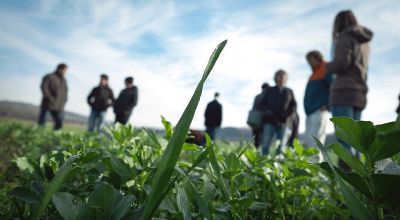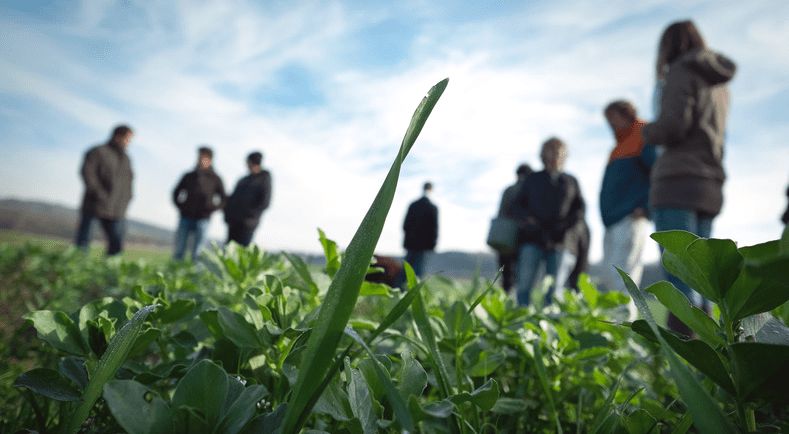Collaboration and cooperation in agriculture
 How to set up a collective (CUMA, GIE, exchange groups), exchange and sharing tools, financial aid, directory, etc.
How to set up a collective (CUMA, GIE, exchange groups), exchange and sharing tools, financial aid, directory, etc.

For some farmers, joining a collective is an opportunity to organise their work more effectively, to think more carefully about particular issues, or to achieve a form of economic security. It is also recognised that for certain topics, particularly the agro-ecological transition, setting up joint projects offers a positive dynamic for learning and sharing experienceNguyen[1] [2] https://journals.openedition.org/developpementdurable/18861#text.
This portal therefore provides a non-exhaustive presentation of the main agricultural collectives in France, as well as their respective issues.
ECOPHYTO collectives
The ECOPHYTO Plan is a government initiative designed to steer the reduction in the use of plant protection products at national levelMinistère[3] It is based on a number of actions, including the creation and running of a number of farmers' groups. Since January 2021, all these groups have been listed on the online platform"collectifs Agroécologie", where their location, description and some of their data can be consulted.
DEPHY FERME groups
'The DEPHY FERME'network (Network for Demonstration, Experimentation and Reference Production on PHYtosanitary-saving systems) involves 3,000 farms committed to reducing (or keeping at a low level) their IFT. These farms are grouped together locally into collectives of around ten farms that are geographically close and belong to the same agricultural sector. They benefit from the advice of a facilitator (Network Engineer) and a dynamic collaboration with other players in their area (research, consultancy, development, associations, other groups, etc.). Their work in the field is recorded, analysed and studied at regional and national level. These groups may be run by various organisations such as chambers of agriculture, CIVAMs, cooperatives, CETAs, GDAs, CUMAs, etc[4]
30,000 groups
The 30 000 groups are groups of farmers dedicated to passing on and consolidating the practices tried and tested in the DEPHY network. They are therefore not subject to the same data collection requirements, but are nonetheless led by a dedicated adviser. Their aim is to roll out low-input cropping systems on more than 30,000 farms, so they are larger groups run by a wide variety of organisations[5]
Agroecological collectives
GIEEs
Groupements d'Intérêts Économiques et Environnemental (economic and environmental interest groups ) are collectives whose status has been granted by the government. They are committed to modifying or consolidating practices with the aim of achieving economic, environmental and social performance through a shared, locally-anchored project.
PEI-AGRI
The European Innovation Partnership is a group of multi-stakeholder projects bringing together farmers, scientists, local authorities and associations to work on a specific agricultural issue. They have an international dimension, bringing together between 10 and 110 players from at least three different countries[6]
Associations
Some associations can be considered to be groups of farmers, and depending on their size they may even be responsible for collective projects such as those mentioned above. This is the case, for example, of the Centres d'Initiatives pour Valoriser l'Agriculture et le Milieu rural (CIVAM ), which bring together a network of nearly 130 associations and groups of farmers working on sustainable agriculture issuesRéseau[7] In the same vein, we can also mention the Groupements d'Agriculteurs Biologiques (GAB ) and the Association pour la Promotion d'une Agriculture Durable (APAD) network, which operate in a similar way.
Cooperatives and economic associations
With almost 2,400 structures throughout France, the cooperative model remains one of the most widespread forms of collaboration in agriculture, the most common form being based on the collection, processing and valorisation of harvests[8] lacooperationagricole.coop/fr/actualites/modele-cooperatif/cest-quoi-une-coop-agricole
However, there are other cooperative models specific to agriculture, such as CUMAs (Cooperatives for the Use of Agricultural Equipment) and supply cooperatives for the group purchase of inputs.
Directory of departmental CUMA federations.
Economic Interest Groupings (EIGs) are also a form of cooperation, but their nature is more technical: they are legal entities designed to regulate the pooling of material or human resources between several farms[9] In agriculture, for example, it can be used to pool crop rotation, as part of a low-input crop protection strategy, or to set up common utility structures such as green waste management.
Self-help groups and employer groups
Agricultural mutual aid
In a way, agricultural self-help groups are a form of cooperation: they are arrangements for the exchange of mutual, free, reciprocal and equivalent services between farmers. These services can be in the form of work or resources, such as the provision of labour or equipment. This form of cooperation can be used on an ad hoc basis to compensate for a temporary inability to work, or it can be integrated into the running of the farm on a more regular basis[10]
GED / GEAR
Groupements d'Employeurs Agricoles et Ruraux (Agricultural and Rural Employers' Groups ) are a fairly common form of administrative collaboration for industries that employ farm workers and seasonal workers. More generally, the aim of such groupings is to secure long-term employment in small businesses, and to balance the supply on a wider scale. Often taking the form of an association, they make a certain number of salaried workers available to their members. In this way, the employees will have to work for different members, but will have a single point of contact, the Groupement d'Employeurs, for administrative formalities[11]
References
- ↑ G. et al, ENSAT, Pratiques agricoles pour la réduction des produits phytosanitaires. le rôle de l'apprentissage collectif, 2013. https://journals.openedition.org/economierurale/3817#text
- ↑ Vergote. M-H. Tanguy C., CESAER, Collectifs d'échanges de pratiques pour écologiser l'agriculture : éclairer les difficultés d'une approche volontaire, 2021.
- ↑ de l'Agriculture et de l'Alimentation, Le plan Écophyto, qu'est-ce que c'est? 2021. https://agriculture.gouv.fr/le-plan-ecophyto-quest-ce-que-cest.
- ↑ .Ministère de l'Agriculture et de l'Alimentation, Les fermes Dephy: partout en France, des systèmes de production performants et économes en pesticides, 2021. https://agriculture.gouv.fr/les-fermes-dephy-partout-en-france-des-systemes-de-production-performants-et-economes-en-0
- ↑ .Ministère de l'Agriculture et de l'Alimentation, Écophyto : objectif 30 000 exploitations agricoles !, 2021. https://agriculture.gouv.fr/ecophyto-objectif-30-000-exploitations-agricoles
- ↑ .Ministère de l'Agriculture et de l'Alimentation, Le Partenariat européen pour l'innovation (PEI-AGRI), 2019. https://agriculture.gouv.fr/le-partenariat-europeen-pour-linnovation-pei-agri
- ↑ CIVAM, 2020. https://www.civam.org/nos-missions/.
- ↑ .Coopération Agricole, consulted on 03 January 2022. https://www.
- ↑ .Ministère de l'Économie des Finances et de la Relance, Le groupement d'intérêt économique (GIE), une structure pour la coopération économique, 2018. https://www.economie.gouv.fr/entreprises/groupement-interet-economique-gie
- ↑ .Mutualité Sociale Agricole, L'entraide agricole, 2021. https://www.msa.fr/lfp/affiliation/entraide-agricole
- ↑ .FNGEAR, Qu'est-ce qu'un Groupement d'Employeurs Agricole et Rural, 2022. https://www.fngear.fr/quest-ce-quun-groupement-demployeurs-agricole-et-rural/